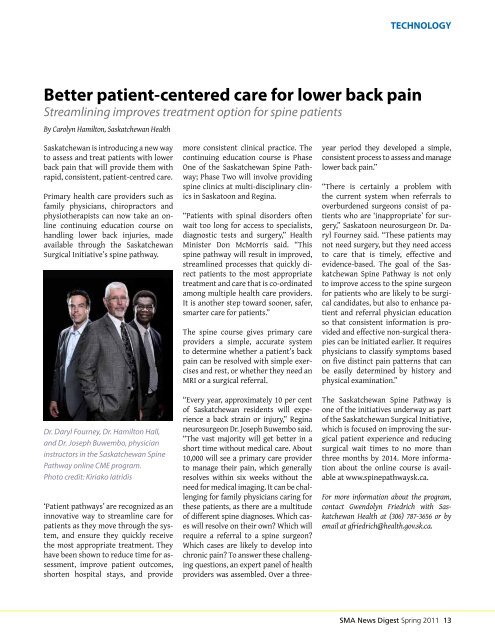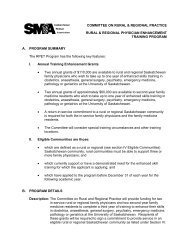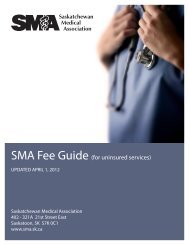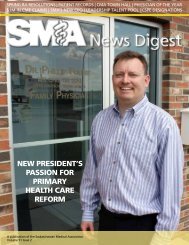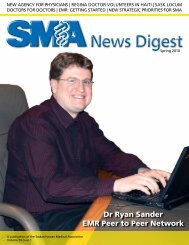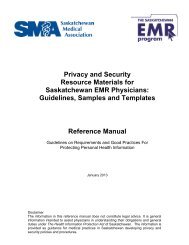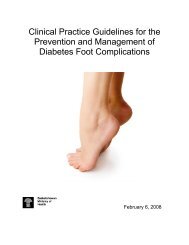Examining collegiality in Saskatchewan - Saskatchewan Medical ...
Examining collegiality in Saskatchewan - Saskatchewan Medical ...
Examining collegiality in Saskatchewan - Saskatchewan Medical ...
You also want an ePaper? Increase the reach of your titles
YUMPU automatically turns print PDFs into web optimized ePapers that Google loves.
Better patient-centered care for lower back pa<strong>in</strong><br />
Streaml<strong>in</strong><strong>in</strong>g improves treatment option for sp<strong>in</strong>e patients<br />
By Carolyn Hamilton, <strong>Saskatchewan</strong> Health<br />
<strong>Saskatchewan</strong> is <strong>in</strong>troduc<strong>in</strong>g a new way<br />
to assess and treat patients with lower<br />
back pa<strong>in</strong> that will provide them with<br />
rapid, consistent, patient-centred care.<br />
Primary health care providers such as<br />
family physicians, chiropractors and<br />
physiotherapists can now take an onl<strong>in</strong>e<br />
cont<strong>in</strong>u<strong>in</strong>g education course on<br />
handl<strong>in</strong>g lower back <strong>in</strong>juries, made<br />
available through the <strong>Saskatchewan</strong><br />
Surgical Initiative’s sp<strong>in</strong>e pathway.<br />
Dr. Daryl Fourney, Dr. Hamilton Hall,<br />
and Dr. Joseph Buwembo, physician<br />
<strong>in</strong>structors <strong>in</strong> the <strong>Saskatchewan</strong> Sp<strong>in</strong>e<br />
Pathway onl<strong>in</strong>e CME program.<br />
Photo credit: Kiriako Iatridis<br />
‘Patient pathways’ are recognized as an<br />
<strong>in</strong>novative way to streaml<strong>in</strong>e care for<br />
patients as they move through the system,<br />
and ensure they quickly receive<br />
the most appropriate treatment. They<br />
have been shown to reduce time for assessment,<br />
improve patient outcomes,<br />
shorten hospital stays, and provide<br />
more consistent cl<strong>in</strong>ical practice. The<br />
cont<strong>in</strong>u<strong>in</strong>g education course is Phase<br />
One of the <strong>Saskatchewan</strong> Sp<strong>in</strong>e Pathway;<br />
Phase Two will <strong>in</strong>volve provid<strong>in</strong>g<br />
sp<strong>in</strong>e cl<strong>in</strong>ics at multi-discipl<strong>in</strong>ary cl<strong>in</strong>ics<br />
<strong>in</strong> Saskatoon and Reg<strong>in</strong>a.<br />
“Patients with sp<strong>in</strong>al disorders often<br />
wait too long for access to specialists,<br />
diagnostic tests and surgery,” Health<br />
M<strong>in</strong>ister Don McMorris said. “This<br />
sp<strong>in</strong>e pathway will result <strong>in</strong> improved,<br />
streaml<strong>in</strong>ed processes that quickly direct<br />
patients to the most appropriate<br />
treatment and care that is co-ord<strong>in</strong>ated<br />
among multiple health care providers.<br />
It is another step toward sooner, safer,<br />
smarter care for patients.”<br />
The sp<strong>in</strong>e course gives primary care<br />
providers a simple, accurate system<br />
to determ<strong>in</strong>e whether a patient’s back<br />
pa<strong>in</strong> can be resolved with simple exercises<br />
and rest, or whether they need an<br />
MRI or a surgical referral.<br />
“Every year, approximately 10 per cent<br />
of <strong>Saskatchewan</strong> residents will experience<br />
a back stra<strong>in</strong> or <strong>in</strong>jury,” Reg<strong>in</strong>a<br />
neurosurgeon Dr. Joseph Buwembo said.<br />
“The vast majority will get better <strong>in</strong> a<br />
short time without medical care. About<br />
10,000 will see a primary care provider<br />
to manage their pa<strong>in</strong>, which generally<br />
resolves with<strong>in</strong> six weeks without the<br />
need for medical imag<strong>in</strong>g. It can be challeng<strong>in</strong>g<br />
for family physicians car<strong>in</strong>g for<br />
these patients, as there are a multitude<br />
of different sp<strong>in</strong>e diagnoses. Which cases<br />
will resolve on their own? Which will<br />
require a referral to a sp<strong>in</strong>e surgeon?<br />
Which cases are likely to develop <strong>in</strong>to<br />
chronic pa<strong>in</strong>? To answer these challeng<strong>in</strong>g<br />
questions, an expert panel of health<br />
providers was assembled. Over a three-<br />
TECHNOLOGY<br />
year period they developed a simple,<br />
consistent process to assess and manage<br />
lower back pa<strong>in</strong>.”<br />
“There is certa<strong>in</strong>ly a problem with<br />
the current system when referrals to<br />
overburdened surgeons consist of patients<br />
who are ‘<strong>in</strong>appropriate’ for surgery,”<br />
Saskatoon neurosurgeon Dr. Daryl<br />
Fourney said. “These patients may<br />
not need surgery, but they need access<br />
to care that is timely, effective and<br />
evidence-based. The goal of the <strong>Saskatchewan</strong><br />
Sp<strong>in</strong>e Pathway is not only<br />
to improve access to the sp<strong>in</strong>e surgeon<br />
for patients who are likely to be surgical<br />
candidates, but also to enhance patient<br />
and referral physician education<br />
so that consistent <strong>in</strong>formation is provided<br />
and effective non-surgical therapies<br />
can be <strong>in</strong>itiated earlier. It requires<br />
physicians to classify symptoms based<br />
on five dist<strong>in</strong>ct pa<strong>in</strong> patterns that can<br />
be easily determ<strong>in</strong>ed by history and<br />
physical exam<strong>in</strong>ation.”<br />
The <strong>Saskatchewan</strong> Sp<strong>in</strong>e Pathway is<br />
one of the <strong>in</strong>itiatives underway as part<br />
of the <strong>Saskatchewan</strong> Surgical Initiative,<br />
which is focused on improv<strong>in</strong>g the surgical<br />
patient experience and reduc<strong>in</strong>g<br />
surgical wait times to no more than<br />
three months by 2014. More <strong>in</strong>formation<br />
about the onl<strong>in</strong>e course is available<br />
at www.sp<strong>in</strong>epathwaysk.ca.<br />
For more <strong>in</strong>formation about the program,<br />
contact Gwendolyn Friedrich with <strong>Saskatchewan</strong><br />
Health at (306) 787-3656 or by<br />
email at gfriedrich@health.gov.sk.ca.<br />
SMA News Digest Spr<strong>in</strong>g 2011 13


